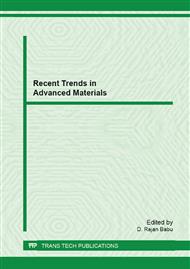[1]
J.G. Liu, B.H. Ye, H. Li, Q.X. Zhen, L.N. Ji, Y.H. Fu, Polypyridyl ruthenium(II) complexes containing intramolecular hydrogen-bond ligand: syntheses, characterization, and DNA-binding properties, J. Inorg. Biochem. 76 (1999) 265–271.
DOI: 10.1016/s0162-0134(99)00154-3
Google Scholar
[2]
N.K. Kaushik, A.K. Mishra, Synthesis, characterization and thermal studies of some new organotin (IV) complexes with aniline N-thiohydrazide and benzaldehyde aniline N- thiohydrazone, Ind. J. Chem. 42A (2003) 2762-2766.
Google Scholar
[3]
B. Dede, F. Karipcin, M. Cengiz, Novel homo- and hetero-nuclear copper(II) complexes of tetradentate Schiff bases: synthesis, characterization, solventextraction and catalase like activity studies, J. Hazard. Mater. 163 (2009) 1148–1156.
DOI: 10.1016/j.jhazmat.2008.07.070
Google Scholar
[4]
A.K. Mishra, N. Manav, N.K. Kaushik, Organotin(IV)complexes of thiohydrazones: synthesis, characterization and antifungal study, Spectrochim. Acta (Part A). 61 (2005) 3097–3101.
DOI: 10.1016/j.saa.2004.11.035
Google Scholar
[5]
M.G. Abd El Wahed, E.M. Nour, S. Teleb, S. Fahim, Thermodynamic and thermal investigation of Co(II), Ni(II) and Cu(II) complexes with adenine, J. Therm. Anal. Calorim. 76 (2004) 343–348.
DOI: 10.1023/b:jtan.0000027834.34263.48
Google Scholar
[6]
Thakor Y.J, Patel S.G., Patel K.N., Synthesis, characterization and biocidal studies of some transition metal complexes containing tetra dentate and neutral bi dentate schiff base, J. of Chem and Pharm Research. 2 (2010) 518-525.
DOI: 10.1081/sim-120016872
Google Scholar
[7]
M.A. Neelkantan, F. Rusalraj, J. Dharmaraja, S. Johnsonraja, T. Jeyakumar, M. Sankarnarayana Pillai, Spectral characterization, cyclic voltammoletry, morphology, biological activities and DNA cleaving studies of amino acid Schiff base metal (II) complexes, Spectochim Acta (Part A). 71 (2008) 1599-1609.
DOI: 10.1016/j.saa.2008.06.008
Google Scholar
[8]
M. R. Prathapachandra Kurup , M. Joseph, Transition Metal Complexes of Furan‐2‐aldehyde Thiosemicarbazone, Synthesis and Reactivity in Inorganic and Organic chemistry. 33 (2003) 1275-1287.
DOI: 10.1081/sim-120023500
Google Scholar
[9]
S. Arturo, B. Giampaolo, R. Giuseppe, L.G. Maria, T. Salvatore, The interaction of native DNA with Iron (III)-N, N'-ethylene-bis (salicylideneiminato)-chloride, J. Inorg. Biochem. 98 (2004) 589–594.
DOI: 10.1016/j.jinorgbio.2004.01.010
Google Scholar
[10]
W. Lewandowski, M. Kalinowska, H. Lewandowska, The influence of metals on the electronic system of biologically important ligands. Spectroscopic study of benzoates, salicylates, nicotinates and isoorotates, J. Inorg. Biochem. 99 (2005) 1407–1423.
DOI: 10.1016/j.jinorgbio.2005.04.010
Google Scholar
[11]
R. Chen, C.S. Liu, H. Zhang, Y. Guo, X.H. Bu, M. Yang, Three new Cu(II) and Cd(II) complexes with 3-(2-pyridyl)pyrazole-based ligand: Syntheses, crystal structures, and evaluations for bioactivities J. Inorg. Biochem. 101 (2007) 412–421.
DOI: 10.1016/j.jinorgbio.2006.11.001
Google Scholar
[12]
N. Davidson, W. Szybalski, Physical and Chemical Characteristics of Lambda DNA in: The Bacteriophage Lambda, Cold Spring Harbor Laboratory Press, Volume 02, 1971, pp.45-82.
Google Scholar


